August 2015-Fall Food Plots
A version of this article is published in the August 2015 Iowa Sportsman Magazine
Introduction–For 2015, I have tried to lay out a habitat improvement plan that could be adopted in whole or in part for any hunter/land manager following along. The plan was meant as a guide in helping you improve your hunting grounds in terms of better habitat on how to create that habitat in a huntable way. I started with equipment needs, moved through security cover and interior food plots, continued with different food plot varieties and the methods for planting them, touched on the Big 5 herbicides, and last month talked about summer planted brassicas. August is my last segment for 2015 dealing with food/habitat. Taken in whole, these eight articles combined (January through August 2015) could be used year after year and expanded upon to improve any hunting ground. In general, I have been repeating the methods and ideas in these eight articles over and over for the past 15 years or so. This eighth and final piece on fall planted green food plots rounds out the last and final piece of the habitat improvement plan any hunter can follow and perform.
Fall Planted Greens-For many hunters, a fall planted green food plot is the lion share of their food plotting. Lack of equipment, time, procrastination, available acreage …are all reasons many hunters only put in one food plot each year in the fall. For me, it’s not so much about those things as it is making sure I have a variety of food sources preferred by deer throughout the hunting season. I also never want to hedge all my bets on one plot or plant variety. Remember back to 2012? I don’t recall a drought as bad as that one in my lifetime. Virtually all my spring and summer planted food plots perished. It was the first time in my life I saw green leaves dropping from the trees! That year, my fall planted green plots saved the season because of some timely rains in September. Green plots are also the only practical choice for those small interior plots or other small food plots. Fall planted annuals or a blend containing a perennial you want to establish is the way to go.
Perennial Establishment vs. Annuals-In most cases, well let me rephrase that…I can’t think of an example when an annual food plot variety or blend planted in early fall wouldn’t perform as good or better than an established perennial. Granted, a perennial plot might offer more food throughout the entire growing season. But I’m planting these plots to hunt over…not necessarily to provide 9 months of food. Remember that drought I talked about in 2012, if you had clover perennial plots planted there was a good chance those plots got burned off and weeds took over. In making the case for planting annual blends each and every fall, let me explain my experiences with perennials.
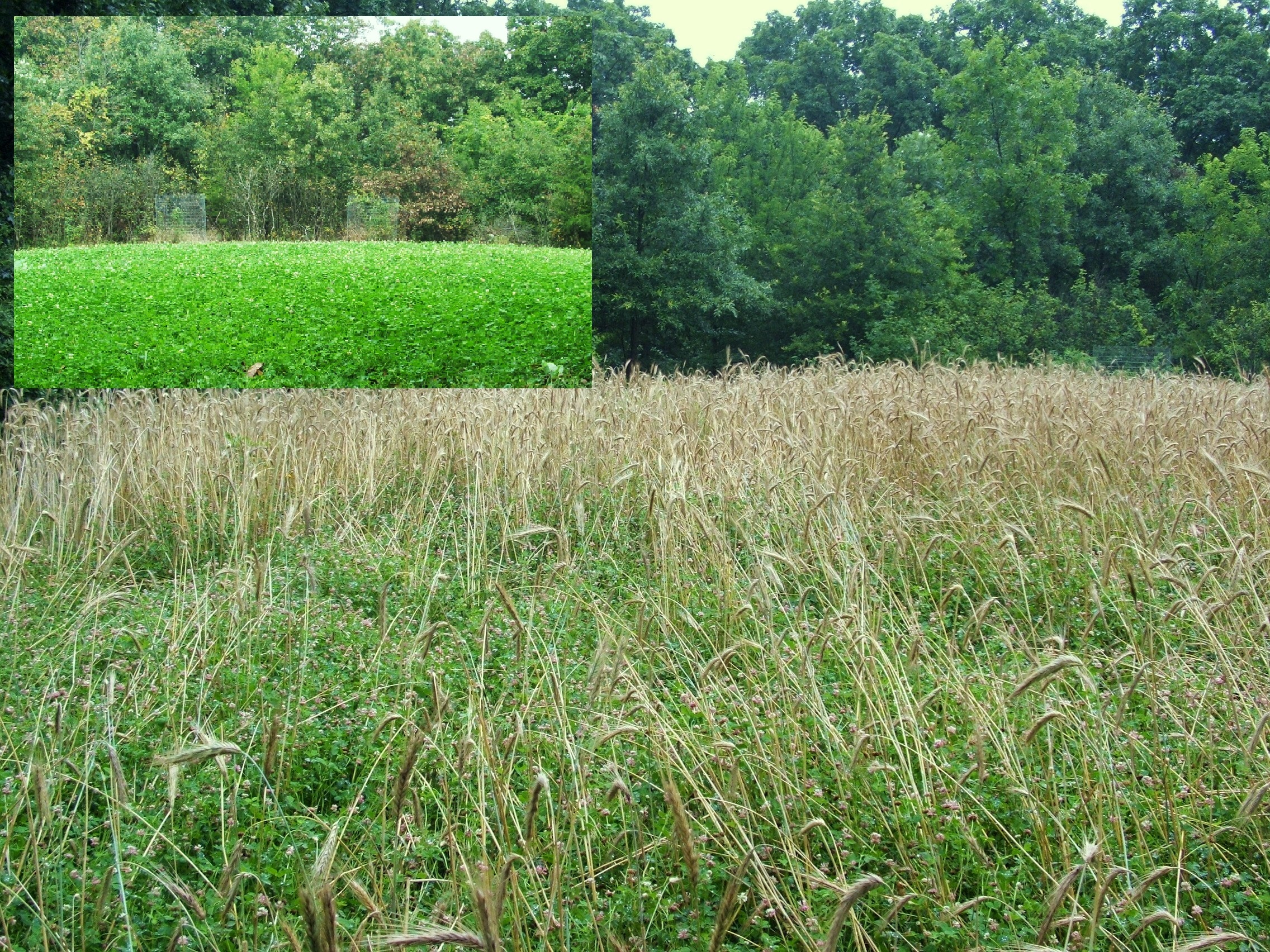
This clover plot was planted in the fall as part of a blend of winter rye, appin turnips, and clover. In late spring the following year you can see the rye becoming mature. This picture was taken right before mowing the year after it was planted in the fall. The picture in the inset on the top/left was taken in late summer…you can see the clover is well established and weed free.
I have never in my life had the convenience of hunting property out my back door…except when I was very young. In almost every instance of trying to establish perennial plots of clover or alfalfa, I found the maintenance in keeping those plots weed free and flourishing to be excessive. I’m not saying they aren’t good choices, but for a hunter on a time budget like I was it didn’t work out so well. Perennials like to get mowed or cut routinely. Alfalfa is finicky and needs a really good Ph to thrive as well as soils that drain well. Clover needs at least a decent amount of moisture or can easily burn off during dry periods in the summer. Week clover or alfalfa is susceptible to weed intrusion…requiring additional mowing or the use of herbicides to control the weeds. Both varieties need good sun light…making them harder to grow in small plots in the timber. I can also pick varieties of plants for my annual plots that are more frost tolerant than clover or alfalfa…thereby extending the plots attractiveness longer into the season. For these reasons, I have generally (not totally) gone away from perennial plots.
Fall Planted Annuals-Around the last week of August each year, I find myself putting in my last and final food plots. In most cases, a fall planting of a blend of annuals is a great choice. If you’ve done your work throughout the summer by spraying or tilling several times, you’ll be entering this stage of the year with good weed free food plots that are ready to plant. Unlike spring planted grain plots or summer planted brassicas, these fall planted greens are all about forage. In a short time, killing frosts will start to change the deer’s world drastically and force the deer herd off preferred green supplies of nutrition to grains, acorns, and more woody varieties of food. By having green plots after the fall harvest and after some killing frosts, you will undoubtedly attract deer. A fall blend that contains varieties of plants that offer good amounts of forage while resisting frost seems like a good logical choice then right?
My favorite fall planted green blend—25 to 30lbs/acre winter rye, 3lbs/acre appin turnips, and 3lbs/acre dwarf essex rape. This blend will cost you about $30/acre when buying bulk agriculture seed or as much as 3 times this if buying marketed food plot seed. Appin turnips are loved by deer and are a variety that puts the majority of their energy into plant or leaf production. They are relatively frost tolerant to some degree and provide tons of food. Rape is a fast germinating and growing brassica with good tolerance of cold temps as well. And then there is the winter rye… winter rye is a favorite of mine for several reasons. First, it is a prolific germinator and will grow well in most conditions with very little care or fertilizer. Second, for a green grain crop it has pretty good nutritional value reaching protein levels as high as 15%. Third, rye is a nutrient scavenger being able to pull nutrients from deep within the soil and is able to use nutrients that aren’t readily available to other species of plants. This is important because next growing season when I till under the green rye I am able to put back as green manure all those nutrients. Lastly, winter rye is ultra-cold weather tolerant being able to grow at temperatures down to 33 degrees and freeze proof down to 30 below zero.
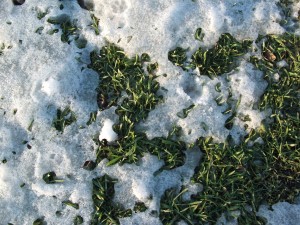
Winter rye is frost proof. This rye is still green in February and will offer a food source all winter.
This means my winter rye when planted in early fall will green up and stay green providing a fall and winter food source all the way through till next spring. Long after every other plant has died or gone dormant from freezing temperature winter rye will still be green and attracting deer. This blend of rye, appins, and rape will simply outperform most food plots planted each fall in terms of attractiveness, length of time available, and cost. It has a great return on your investment. Seeding rate is 25lbs/acre winter rye, 3lbs/acre appins, 3lbs/acre rape.
Establishing a Perennial Plot in the Fall-In cases when I want to establish a perennial plot of clover or alfalfa, I have found that the best time to do this is a late summer planting. Late summer plantings are great for weed control as competition from weeds will be at its lowest level in the growing season. A seed bed kept sprayed or tilled throughout summer will offer the clover or alfalfa the best chance to sprout and compete. Because the clover/alfalfa will already be established going into winter, they will explode next spring and get out ahead of any competing grasses or broad leafs. Germinating perennials won’t grow very fast; therefore I plant them in a blend so that I have a great fall food plot while establishing the perennial. I use a blend of winter rye, appins, and clover for this set up at rates of 25, 3, and 5lbs/acre respectively. If using alfalfa, seed at a higher rate of about 15lbs/acre. The rye and appins will provide a great plot for this fall. The clover or alfalfa will germinate and take hold so they are ready to explode next spring to establish themselves. This is the best way I have found to establish a great perennial plot. It should be noted that next spring the winter rye will come up and grow right along the clover or alfalfa. I usually let the rye grow up to almost maturity before mowing it off as the cover crop properties of the rye will actually help the perennial establish.
Planting Methods-Both the annual and perennial blends are fairly easy to plant. The key to having a good fall green plot is weed control throughout the summer. The area should be tilled or sprayed to keep the weeds eliminated.
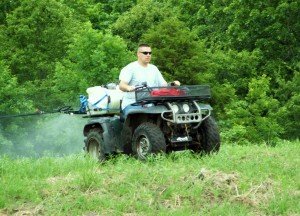
Spraying plots you plan to plant in the fall is a good way to stay ahead of weeds.
I like to use glyphosate herbicide so that there is no residual action with the chemical that could affect my late summer/fall planting. Tilling is also a good choice but will most likely require you to do this several times. Many times I will put these fall plots into ground that was planted in soybeans in the spring. The soybeans have been fixing nitrogen for me all summer and if they have canopied over the weeds will be gone.
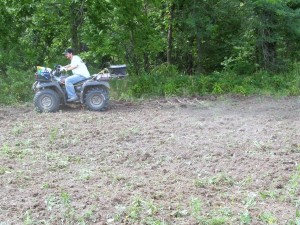
Pulling a drag will compact the soil slightly and sow the seeds at a good depth.
Using a tractor and disc, I work the area to create a good dirt seed bed. I spread the seed blend over the bed and either drag the seed in or very lightly disc again to sow the seed. If you have a way to pack the soil this is also a good idea. I use a tine drag after spreading the seed which gets me good seed depth and also packs the soil somewhat. Because this is a blend of rye, brassicas, and possibly a legume…I find a couple bags of triple 17 or similar fertilizer is usually just about right if adding fertilizer. Fertilizer can be added right when the seed is spread and sowed in together.
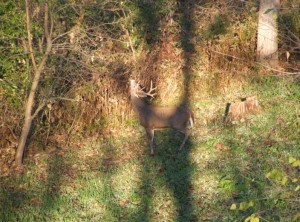
I took this picture of a nice buck making a scrape in an interior plot planted in rye, appins, and rape. Notice very few brassicas remaining.
This year on my farm I will be once again planting green food plots around the last week of August. This is also the time of year to over-seed soybeans with brassicas or winter rye (that’s material for another article). In September’s article I will focus on last minute preparations for the hunt…stands, exit and entrance routes, mowing, etc. I like to think that everything we do from January until now is all about Setting the Trap…now is the time to start getting ready to take advantage of the hard work, time, and money we have invested on our hunting grounds.
